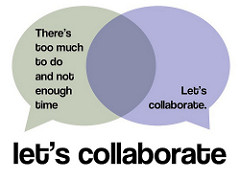The past five or so years have been filled with plenty of talk about and some success in the area of collaboration. Collaboration being defined as multiple people fully engaged and involved in a single work effort. The end goal of any collaboration is that the combined effort produces superior results, ie. a better decision, a better product, a better presentation.
Much of the success in the field of collaboration has come in the area of communication, such as messaging applications like Slack or AIM. These applications improve the communication and are instant and flexible including group chats. Other areas of collaboration, like co-creating documents, such as a live spreadsheet or text document, have not been adopted as quickly. But this form of collaboration has historically been linear, passing from person to person. So can the non-linear form of collaboration (live group editing) be a better approach for working with documents?
Here are two examples of situations that require collaboration on a document; creating a PowerPoint presentation and negotiating a contract. In the case of the PowerPoint presentation, it is very conceivable that one or many users could benefit from having the slides up and each user making minor modifications in real time for all to see. Communication would be verbal in this situation. As long as all participants felt like their voice was heard, it can be an effective method to generate a good end product.
For the negotiation of a legal contract, most likely including users outside of the company, it is much less likely and almost inconceivable that both lawyers would have the document up and making live changes towards a final document. There may be live discussion, but not likely live edits. Negotiating a contract seems to fit the linear workflow model. The collaboration tool needs to accommodate the use of comments or notes and notifications and provide time for private contemplation and discussion.
Assisting with all forms of collaboration is the concept of version control where the document management system ensures all versions are saved and only the most recent version of a document is visible. Many users can make modifications provided the document is not “locked” by another user that is editing it. This form of collaboration seems to benefit the linear model the most.
Workflow can also be a great collaboration tool and it is predominantly linear. Linear workflow utilizes the concept of versions and also includes messaging. The steps in the process are generally known so the process of collaborating is preconfigured or controlled. User 1 creates the document and sends it to User 2 for review. User 2 either approves that document or makes changes and sends it back for review. Eventually the document goes to User 3 who takes action on it such as sends it to the customer or pays the bill.
Which method is best is dependent on the need and circumstances. A non-linear, group solution to the look and feel of a marketing piece may very well be accomplished best in a group session. Whereas the drafting and negotiating of a legal document may require private consideration and consultation, so more of a linear approach. There is also the need to understand the current and future staff and their willingness to change to either a workflow method of collaboration or the non-linear, real-time collaboration. Either way, you should have a collaboration solution that can match the needs of your process and staff to get the best end result.

